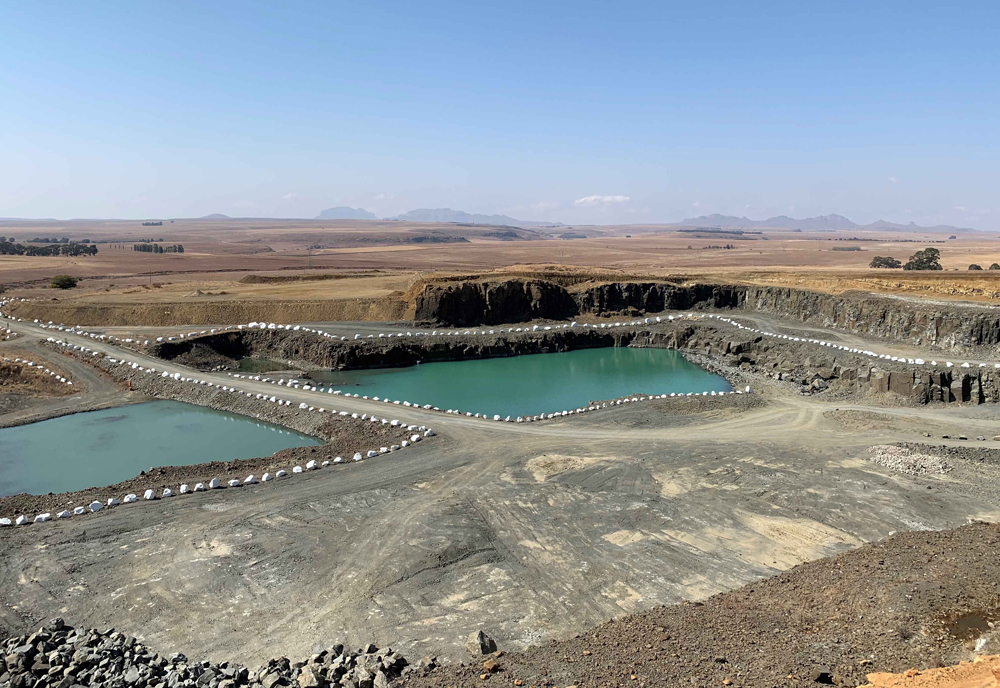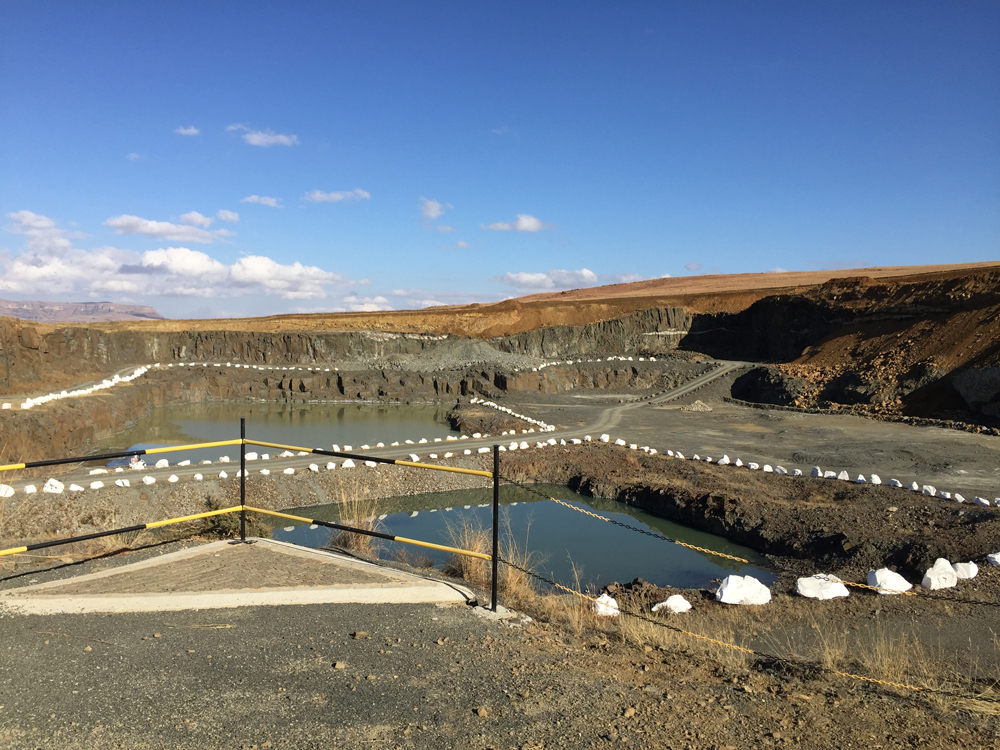
When talking about health and safety in general, it would be fair to cast the spotlight on South Africa, where the legacy from earlier attitudes to worker safety still resonates in the drive to continually improve safe mining and quarrying conditions. Moving into their fifth consecutive year without a fatality, members of surface mining industry association, ASPASA, are surely leading the way as far as health and safety is concerned.
Central to this feat is ASPASA’s meticulous health and safety regime, which ensures the highest standards of compliance of member operations. Some 20 years ago, the association started its Health and Safety (ISHE) Audit for the industry to ensure that its members adhere to the most stringent health and safety parameters.

One operation that has set the bar high as far as consistently maintaining unparalleled standards is Harrismith Quarry, located in the Free State province of South Africa. Owned and operated by Afrimat, a leading open-pit mining company providing industrial minerals, bulk commodities and construction materials, the quarry has achieved Showplace Status (95% and more), in ASPASA’s ISHE Audit for eight years running.
The total ISHE Audit protocol covers more than 700 questions that must be answered and verified with objective evidence, where a possible total of ±3 900 points are awarded. To be awarded a Showplace Status, the quarry must achieve a minimum final score of 95% on the ISHE Audit. If a quarry records a disabling injury, lost time injury, occupational disease or fatal accident during the auditing period, the audit protocol carries extreme negative marks against the operation, meaning it cannot achieve Showplace Status.
The feasibility of establishing a quarry on the current Harrismith Quarry site was confirmed in February 1988 with the first stone produced in July 1988. The operation was started to service the Harrismith area. An existing quarry in the Qwa Qwa area existed but could not service the two growing towns of Puthajithaba and Harrismith. The Harrismith Quarry was established on a site that had previously been quarried to provide material for the construction of the Sterkfontein dam.
The operation, which mines a dolerite rock, produces several material sizes including 10 mm; 14 mm; 20 mm; 28 mm; G2; G4; G5, G6; blasted rock, overburden, primary crush, gabion stone, builders blend and crusher dust. It also supplies customers with unique specifications on request.
ASPASA ISHE auditor Marius van Deventer says when you enter this operation, the first impression that you get is “neat and tidy”. Then, he adds, “you meet with the mine manager, Anton Marnewick, who was a recipient of a special recognition award from ASPASA in 2017, with his clean, shining boots, together with his disciplined and professional team, and you realise that there is a special bond of teamwork keeping everybody together.”
Indeed, Marnewick, quarry manager Qwa Qwa & Harrismith at Afrimat, credits teamwork as one of the cornerstones of success at Harrismith Quarry. “Buy-in from the workforce with regards to safety has been one of the recipes for our success over the years,” he says.
Accountability by every individual on site also makes health and safety compliance a breeze at Harrismith Quarry, adds Marnewick. “We strive to make employees responsible for their own safety, as well as that of others and the areas where they work,” he says. Regular training programmes have also made sure that employees are well informed of what is required of them in terms of health and safety on site.
Other initiatives central to the operation’s Showplace Status for eight years running are regular monitoring and inspections; continuous upgrades on the plant and site to comply with changing legislation, and effective maintenance. “A premium has always been placed on neatness and orderliness. The old adage of ‘a neat workplace is a safe workplace’ applies to Harrismith Quarry and has instilled a sense of pride,” adds Marnewick.
Van Deventer agrees: “During the 2020 ISHE Audit, I asked the manager to stop one of his dumper operators as I wanted to inspect the machine and question the operator on his pre-start checklist and operator licence. When the operator got out of his dumper, after following all the procedures of stopping his machine and making it safe to get out, I immediately noticed the shining safety boots. This is an example of a company culture of neatness and orderliness,” he says.
“Harrismith Quarry is a small operation, but the manager will immediately remind you that the risks are exactly the same as at any other operation. Everything is well maintained and kept in an orderly and safe manner. Employees are eager to share information and point out the improvements made since the previous audit. Very high standards in the development and implementation of the health & safety system are achieved through teamwork, commitment and dedication,” says Van Deventer.
Commenting on the company’s attitude towards safety, Letisha van den Berg, head of Health and Safety at Afrimat, says the company cares for the wellbeing of all staff and recognises its workforce as a meaningful and important contributor towards its core values.
It is the company’s policy, says Van den Berg, to use its health and safety management system to do all that is reasonably practical to prevent occupational diseases, personnel injury, damage to property, and to protect all employees, visitors, contractors, public, and interested and affected parties from foreseeable work hazards, insofar as they come into contact with the operations or are exposed to working practices within the company.
“We follow a proactive and participative approach to health & safety management, both within the boundaries of our operations and the integration thereof with surrounding areas. This means that we will endeavour to proactively identify and resolve potential health & safety risks before they manifest as accidents, incidents or compliance non-conformances,” she says.
“We ensure a healthy and safe working environment as our primary responsibility. We lead our health & safety effort by example. We furthermore believe that, in self-interest and for the collective good, every employee should participate in and contribute towards our health & safety effort. We will encourage and empower staff in appropriate ways to work together as a team to fulfil this responsibility,” adds Van den Berg.
The company, says Van den Berg, also strives to integrate health & safety management in routine management functions and processes. Afrimat also seeks to proactively identify and eliminate (or as a last resort, manage) all occupational health & safety related risks in the workplace.
“We also strive to comply with all internal health & safety standards as well as with applicable legislation; inform staff of the hazards and risks associated with their work, and provide training, equipment and support necessary for our employees to mitigate risks and perform safe, healthy and productive work. Additionally, we monitor and report our health & safety performance, working towards a goal of zero incidents, through a continuous improvement of our performances and health & safety systems,” she says.

There is general consensus that COVID-19 has affected businesses in many ways and managing health and safety during the pandemic has been one of the key challenges brought about by the coronavirus. For Harrismith Quarry, however, it was business as usual in 2020. Managing health and safety on site during COVID-19, says Marnewick, is no different to managing it when there was no pandemic. “Rules are rules and should be adhered to in any circumstance,” he declares.
What was new, however, was the personal aspect and operating under the uncertainty of what the pandemic brought, he adds. Personal hygiene, social distancing and sanitising, although not foreign, were just difficult to enforce in the beginning.
“From day one, when it was decided to reopen the quarry after the lockdown, management and staff were all on board and started with all the necessary posters, social distancing signs, sanitising stations, training of the security staff, employees and transporters, among others. Pre-screening was arranged with our occupational medical practitioner and was set up prior to starting up,” he says, adding that there were also constant updates and new procedures and documents coming through from the safety department to share with employees.
“For Afrimat, safety goes far beyond compliance and how we act. It forms an integral part of our Afrimat Values system. Safety is part of who we are and resonates with our company culture. The Showplace award is a result of both management and staff subscribing to the Afrimat culture and living the Afrimat values.”
In the end, the quarry achieved a 96.17% mark, placing it third in the overall ISHE Audit for 2020. “Harrismith Quarry could not have achieved this milestone without the commitment of all its employees. It is to them that congratulations and thanks are due,” concludes Van den Berg.









